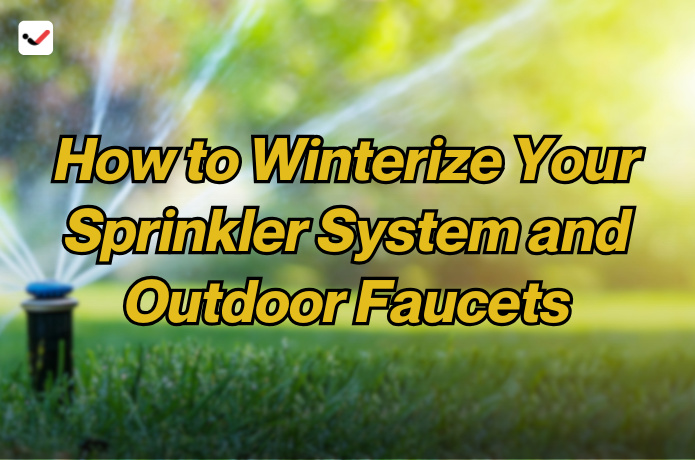How to Winterize Your Sprinkler System and Outdoor Faucets
How to Winterize Your Sprinkler System and Outdoor Faucets

As winter approaches, it’s crucial to protect your home’s outdoor water systems from freezing temperatures. If not properly prepared, water inside sprinkler systems and outdoor faucets can freeze, expand, and cause pipes to burst, leading to costly repairs. Winterizing these systems ensures they stay in good working condition throughout the colder months, saving you money and preventing damage.
Winterizing your sprinkler system and outdoor faucets isn’t as complicated as it might seem. With some basic steps and the right tools, you can effectively prepare your outdoor plumbing for winter. This guide will walk you through the process to help protect your property from winter-related plumbing issues.
Why Winterizing is Important
Winterizing your sprinkler system and outdoor faucets is essential to prevent damage from freezing temperatures. When water freezes, it expands, which can put extreme pressure on your pipes, hoses, and sprinkler heads. This pressure can cause cracks and leaks in the plumbing, leading to water damage or expensive repairs when the weather warms up again.
Even a small crack in a pipe can allow water to seep into your foundation or cause flooding in your yard. Taking the time to properly prepare now can save you both time and money in the long run. Plus, it ensures your system will be ready to use again in the spring without any hassle.
Step-by-Step Guide to Winterizing Your Sprinkler System
1. Turn Off the Water Supply
The first step in winterizing your sprinkler system is to turn off the water supply. Locate the shut-off valve for your sprinkler system, which is usually found in your basement, crawl space, or utility room. Turn it off to stop the flow of water to the system. This step ensures that no more water enters the pipes, reducing the risk of freezing.
2. Drain the Sprinkler Lines
Draining the water from the sprinkler lines is one of the most important steps in winterization. There are three common methods for draining sprinkler systems: manual drain, automatic drain, and blow-out method. Here's a quick overview of each:
Manual Drain: This method requires you to open the drain valves manually. After turning off the water supply, locate the drain valves along the sprinkler lines and open them to let the water out.
Automatic Drain: If your system is equipped with automatic drain valves, they will open automatically once the water pressure drops below a certain level.
Blow-Out Method: This involves using an air compressor to blow out any remaining water from the sprinkler system. Connect the air compressor to the blow-out port and gradually release air into the system, pushing the water out through the sprinkler heads. Be careful not to use too much pressure, as this can damage the pipes.
3. Protect the Backflow Preventer
Your backflow preventer plays a key role in keeping your drinking water supply safe from contamination. It is important to protect it from freezing temperatures. After draining the system, wrap the backflow preventer in insulation or use a specialized cover. This helps prevent it from freezing and cracking during the winter months.
4. Shut Down the Controller
If your sprinkler system is equipped with a controller or timer, it’s a good idea to shut it down or switch it to a “rain” or “off” setting for the winter. This prevents the system from turning on during the cold months when you don’t need irrigation.
5. Inspect the System
Before you finish winterizing your sprinkler system, take the time to inspect all the components for any signs of damage. Check the sprinkler heads, pipes, and valves to ensure everything is in good condition. If you notice any issues, make repairs before winter sets in.
Winterizing Your Outdoor Faucets
Just like your sprinkler system, outdoor faucets are vulnerable to freezing temperatures. To prevent frozen pipes and water damage, follow these simple steps to winterize your outdoor faucets.
1. Disconnect and Store Garden Hoses
One of the easiest and most important steps is to disconnect your garden hoses from outdoor faucets. Leaving hoses connected can trap water inside the hose and faucet, which can lead to freezing and expansion. After disconnecting, drain the hoses completely and store them indoors.
2. Turn Off the Water Supply to Outdoor Faucets
Many homes have a shut-off valve specifically for outdoor faucets, typically located inside the house near the faucet. Turn this valve off to stop the flow of water to the outdoor spigots. If your home doesn't have a separate valve, consider installing one for future winterization.
3. Drain the Faucets
After turning off the water supply, open the outdoor faucets to drain any remaining water inside. Let the water flow out completely. If possible, leave the faucets open throughout the winter to prevent any trapped water from freezing inside.
4. Install Faucet Covers
Outdoor faucet covers provide an extra layer of protection against freezing temperatures. These covers are inexpensive and easy to install. Simply place the cover over the faucet and secure it in place. This helps to insulate the faucet and protect it from freezing temperatures.
Additional Tips for Winterizing Outdoor Water Systems
Insulate Exposed Pipes: If you have any exposed pipes leading to your sprinkler system or outdoor faucets, make sure to insulate them. Use foam pipe insulation or heat tape to protect them from freezing temperatures.
Check for Leaks: Before winterizing, check for any leaks or drips in your sprinkler system or outdoor faucets. Repairing leaks now can prevent bigger issues when temperatures drop.
Monitor Weather Conditions: Keep an eye on the weather forecast, especially during late fall when temperatures start to dip. Winterize your outdoor water systems before the first freeze to avoid any last-minute rush.
When to Call a Professional
While many homeowners can handle the process of winterizing their sprinkler system and outdoor faucets, there are times when it’s best to call a professional. If you’re unsure about how to drain the system properly or don’t have the right tools, a professional can ensure that the job is done correctly. This can give you peace of mind knowing that your system is fully protected for the winter.
Additionally, if your system has complex components or you’ve experienced issues in the past, a professional can offer expert advice and repair any potential problems before winter sets in.
Winterizing your sprinkler system and outdoor faucets is a vital task that protects your home from the potential damage caused by freezing temperatures. By turning off the water supply, draining the system, and insulating vulnerable components, you can avoid costly repairs and ensure that your outdoor plumbing is ready for the spring. Whether you choose to tackle this job yourself or hire a professional, it’s important to complete these steps before the first freeze to keep your water systems running smoothly throughout the winter months.

